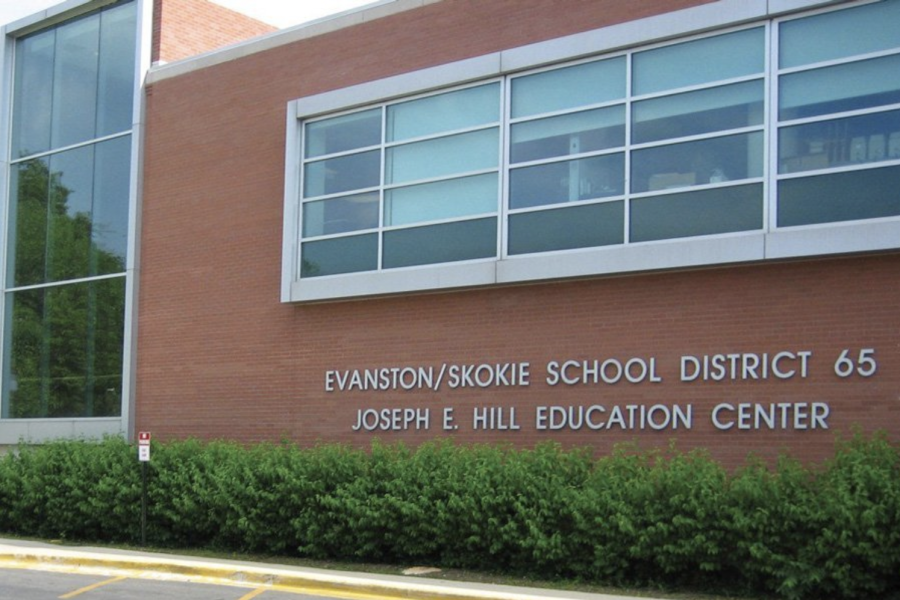D65 two-way immersion program centers Spanish language development, promotes cultural identity
Daily file photo by Patrick Svitek.
A District 65 school building. Evanston Township High School uses the software that District 65 switched to, so Assistant Superintendent of Student Services Romy DeCristofaro said the change would make communication with ETHS easier.
February 7, 2022
Evanston/Skokie School District 65’s Two-Way Immersion program has enriched the bilingual education of native Spanish and English speakers.
The program places English as a second language students in a bilingual classroom rather than an isolated class. It has helped native Spanish speakers grow fluency in Spanish as well as English for more than 20 years, according to the district’s Bilingual and ESL Program Director Amy Correa.
Correa is a native Spanish speaker and Cuban refugee. She said it’s important for students to retain their home language because it is an essential part of cultural identity.
“This program is for the Spanish-speaking community,” Correa said. “It is based around them.”
About half the students in the program’s classes are native Spanish-speakers, who are automatically placed into the program according to Correa. The other half are native English speakers, admitted through a lottery system.
According to a 2020 study, native Spanish-speaking students enrolled in two-way immersion programs generally reached English proficiency faster than students in programs that did not support native-language use, leading to higher GPAs in fifth grade.
“The goal of the TWI program is for students to develop strong literacy skills and language proficiency in both English and Spanish, in order for them to become bilingual, biliterate and bicultural,” according to D65’s website.
Instruction in these programs are a mix of Spanish and English. In kindergarten and first grade, 80% of the day is taught in Spanish, including science, math and literacy classes. By fourth grade, instruction time is evenly split between English and Spanish.
The program is offered K-5 at Dawes, Dewey, Oakton, Washington, and Willard schools. The Dr. Bessie Rhodes School of Global Studies only offers it from K-3 but is expanding the program.
District 65’s curriculum employs visuals, multimedia and a focus on speaking skills to teach bilingualism through other class subjects.
Correa explained the program focuses on making explicit comparisons between the structures of English and Spanish, specifically through teaching common Latin roots.
A year and a half of virtual instruction created difficulties for the program. According to Charlise Berkel, the bilingual content facilitator for District 65, some students are only exposed to Spanish instruction in the classroom
“The level of interaction that could take place in e-learning was not quite as interactive and engaging, conversational-wise and discussion-wise, as being in a live classroom,” Berkel said.
The immersion program is part of a large effort at District 65 to promote equity and inclusion. Instructors use a culturally responsive approach, meaning that TWI teachers come from diverse backgrounds and literacy classes use picture books from Latin American writers, not just translated English materials and the teaching staff.
Correa said that Spanish-speaking students benefit from being in a classroom with native-English speakers, rather than an isolated ESL class.
“There’s this sense of others having to look to them as the knowledgeable other,” Correa said.
In non-immersion classes, ESL students are still working to improve their English, whereas in Spanish immersion classes, peers turn to ESL students as role-models and teachers. To Correa, this is an essential social-emotional element of the program.
Berkel said the Two-Way Immersion program also allows students to progress in English without losing their native language or cultural identity.
“You’re educating the whole child with bilingualism as a norm, not something that is from a deficit perspective, that has to be fixed because you are not up to the level of a monolingual English speaker,” Berkel said. “It affirms their identity and provides ways of sustaining and growing that identity as a bilingual.”
Email: [email protected]
Twitter: @isabelle_butera
Related Stories:
— Evanston’s only fully Spanish Immersion preschool focuses on inclusive education
— D65 Student Assignment Project discusses magnet programs, African-Centered Curriculum
— Bessie Rhodes School principal leaves in midst of 2-way immersion program transition












